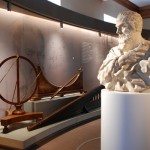 Florence’s science museum, reopened in June 2010 after renovation and renamed Museo Galileo, within six months was awarded one of three prestigious “best mu- seum” prizes by ICOM Italia, the national committee for museums. The prize, for best management was awarded due to “the high-quality
Florence’s science museum, reopened in June 2010 after renovation and renamed Museo Galileo, within six months was awarded one of three prestigious “best mu- seum” prizes by ICOM Italia, the national committee for museums. The prize, for best management was awarded due to “the high-quality
scientific staff, experienced management personnel, its historic non-profit status, and the participation of many agencies and institutions which make it an effective model of museum organization and sustainable management”.
I decided to road test the museum, and after scoping out its website, realised it would be a great place to take my kids. They have a program called “Florence for Family” each weekend until the end of June which has a series of 90 minute guided visits specifically catering for “children over the age of six”. However we didn’t take the tour option, but just vis- ited the museum.
Museo Galileo is home to the only surviving instru- ments designed and built by Galileo himself. It is also the repository for the priceless scientific collections of the two dynasties that once ruled Florence: the Medici and the House of Lorraine. On display are more than 1,000 instruments and devices of major scientific importance and exceptional beauty.
While the focus of the entire exhibition is Galileo, the lay- out of the museum on two levels divides the collection by period, with The Medici collections on the first level. These bear witness to the
scientific culture of Galileo (and his contemporaries) and the tools he designed and made, including two of his telescopes. The second level houses the instruments and ex- perimental apparatuses acquired by the Lorraines in the 18th and 19th centuries, demonstrating the powerful stimulus provided by Gali- leo’s discoveries to the develop- ment of the physical and mathemat- ical sciences in the modern age.
The museum has a brilliant interactive website in English and Italian, which is well worth view-
ing before your visit, as it describes the gallery layout and the 18 themed rooms. Also highly recommended at the museum itself is the €5 audio-visual guide which explains every item in the collection as well as its inventor/builder. The guide automatically senses which room of the museum you are in, and when you enter the exhibit number, the information is displayed on the screen. Some of the more complicated models and experimental devices have a short video explanation as well. All of the information on the guide can also be seen on the website. Unless you are a serious science expert, most of the exhibits just look like funny gadgets that probably have some obscure function. This is why the audio-visual guide is indispensible – providing information on the period of the discovery / invention as well as its creator. Even with the guide, my two youngest children (aged 6 and 9), were quickly and soundly bored after just a couple of minutes. There were several exhibits that did interest my nine year old, but there wasn’t a great deal in if for him. However my two older children (aged 12 and 14) were absolutely enthralled and loved the visit. Many of the items, once explained on the guide,
brought relevance to material they had al- ready studied at school. While my visit was shorter that I would have liked ow- ing to the need to remove my disinter- ested and distracting younger children, I thought the museum was exceptional. It successfully demonstrates how astro- nomical, scientific and mathematical concepts evolved, and the power of
man’s imagination. What is notable, apart from the creativity and evolved thinking is the extraordinary craftsmanship of
the instruments, especially given their age. The museum is sleek, stylish, and thoughtfully laid out allowing excellent viewing of
each exhibit. Not to be missed is the room sized Ptolemaic armillary from 1588 (a model of the solar system showing planet Earth as the central orb), Galileo’s original telescopes as
well as one of Galileo’s fingers. The museum is a fitting tribute to the man who was clearly one of the world’s greatest original thinkers, who challenged the ac- cepted thinking of his time, took on the Catholic Church and was excommunicated and lived out his final years under house arrest.
Museo Galileo, Piazza dei Giudici 1, 50122 Florence, tel. +39 055 265 311; web: www.museogalileo.it Opening hours: Daily: 9.30-18.00, except Tuesdays 9.30-13.00. Entrance fees Full fee € 8,00; 7-18 years old, or over 65 years old € 5,00. 0-6 years old free access. Family ticket (2 adults + max 2 children under 18) € 20,00. Also Group Rates.
About Tuscany Tours Tuscany things to do
The Top Ten Towns of Tuscany – #8 Fiesole
Fiesole Archaeological Site The Archaeological area of Fiesole, near Florence, includes Etruscan and Roman remains. There are three main Etruscan features still visible: – The Etruscan Temple. It is situated on the northern side of the site and it dates back to the fourth Read more…
0 Comments